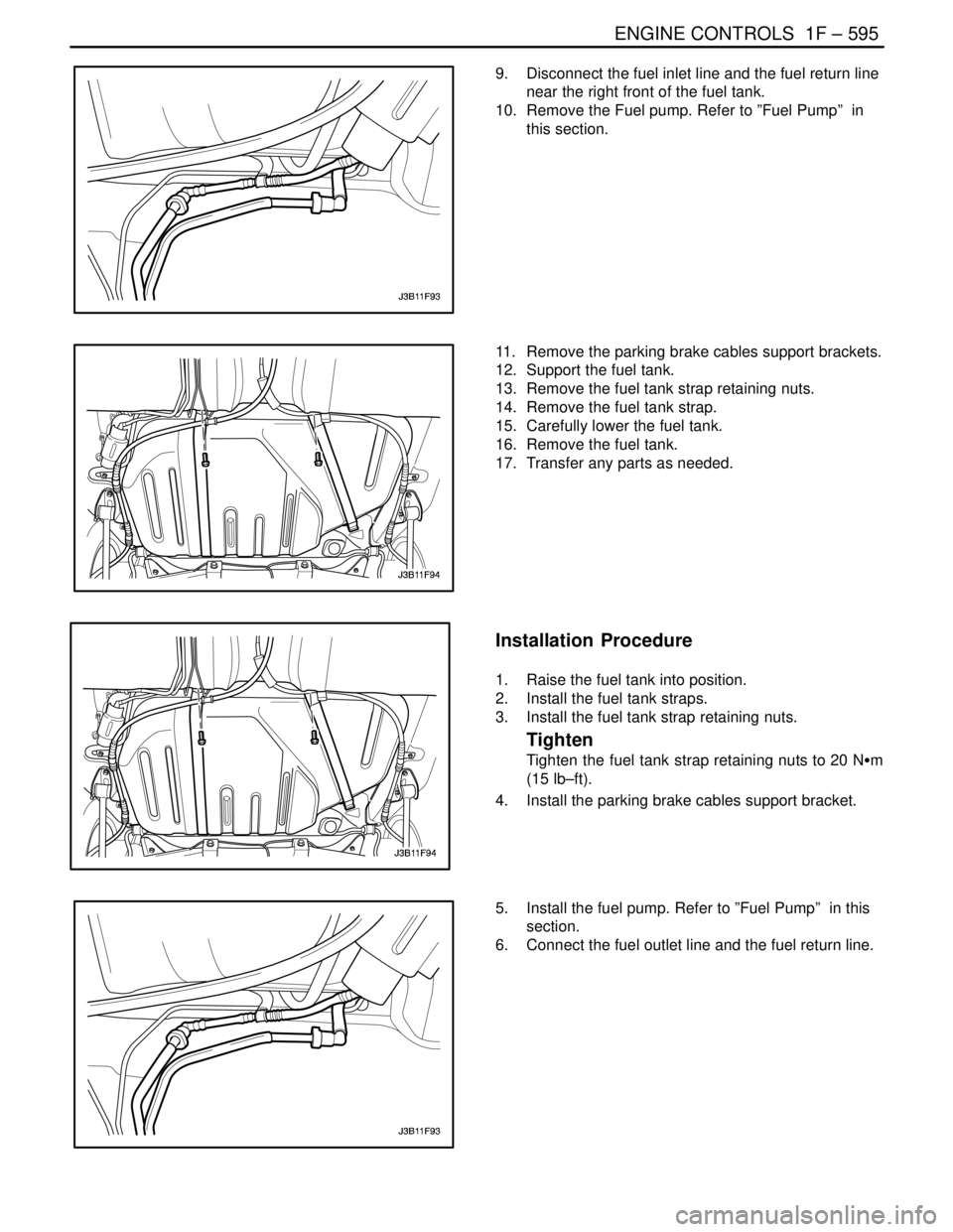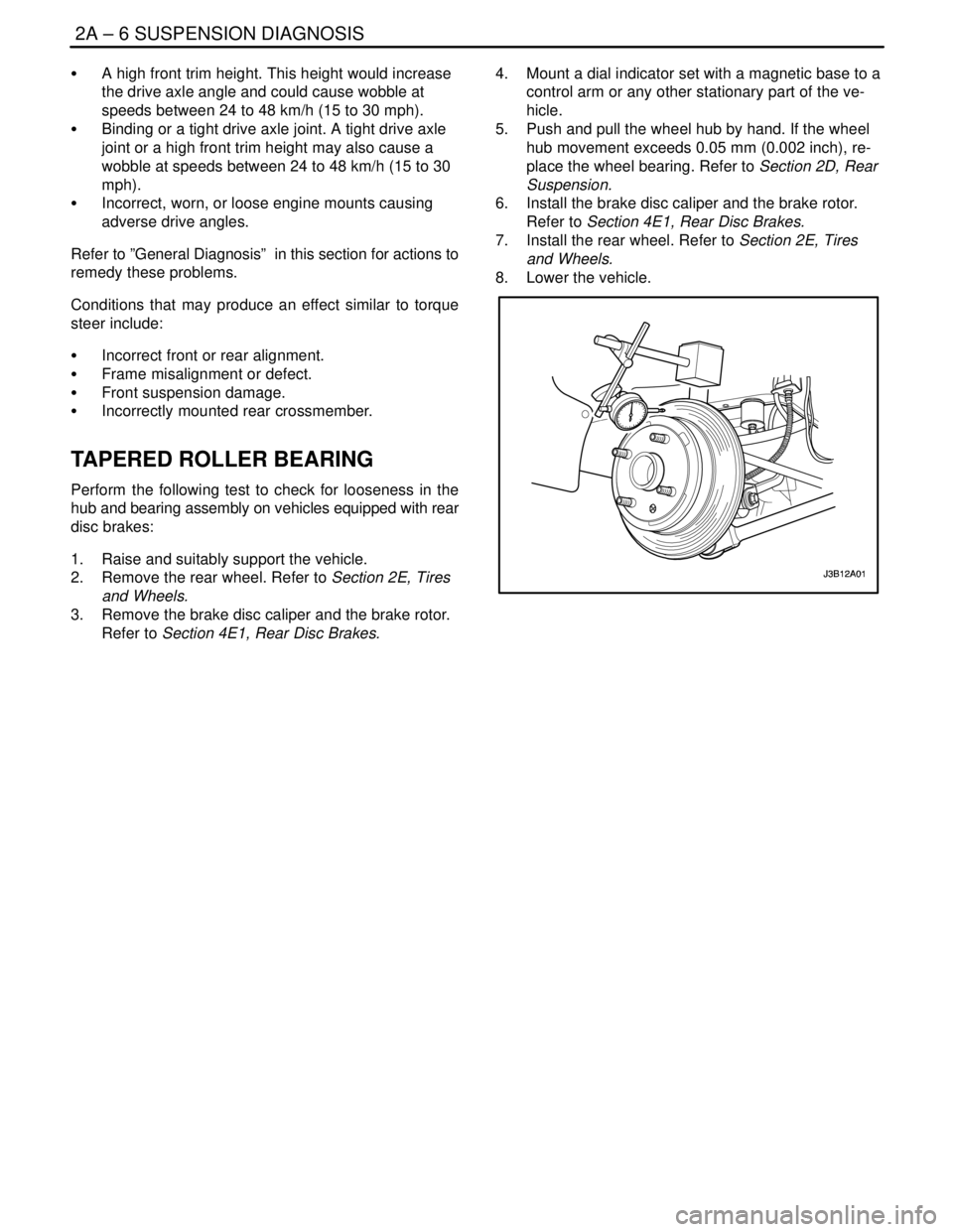2004 DAEWOO LACETTI brake
[x] Cancel search: brakePage 796 of 2643

1F – 550IENGINE CONTROLS
DAEWOO V–121 BL4
DIAGNOSTIC TROUBLE CODE (DTC) P1336
58X CRANK POSITION TOOTH ERROR NOT LEARNED
Circuit Description
In order to detect engine misfire at higher engine speeds,
the Engine Control Module (ECM) must know of any varia-
tion between the crankshaft sensor pulses. Most varia-
tions are due to the machining of the crankshaft reluctor
wheel. However, other sources of variation are also pos-
sible. A Crankshaft Position (CKP) system variation learn-
ing procedure must be performed any time a change is
made to the crankshaft sensor to crankshaft relationship
of if the ECM is replaced or reprogrammed. The ECM
measures the variations and then calculates compensa-
tion factors needed to enable the ECM to accurately de-
tect engine misfire at all speeds and loads. A scan tool
must be used to command the ECM to learn these varia-
tions. If for any reason the ECM is unable to learn these
variations or they are out of an acceptable range, the ECM
will set Diagnostic Trouble Code (DTC) P1336. An ECM
that has not had the CKP system variation learning proce-
dure performed due to replacement or reprogramming will
also set DTC P1336.
Conditions for Setting the DTC
S Tooth error not learned if the manufacture enable
counter is set to zero.
S DTCs P0106, P0107, P0108, P0117, P0118,
P0122, P0123, P0132, P0201, P0202, P0203,
P0204, P0325 , 0327, P0336, P0337, P0341,
P0342, P0351, P0352, P0402, P1404, P0404,
P0405, P0406 and P0502 are not set.
Action Taken When the DTC Sets
S The Malfunction Indicator Lamp (MIL) will illumi-
nate.
S The ECM will record operating conditions at the
time the diagnostic fails. This information will be
stored in the Freeze Frame and Failure Records
buffer.
S A history DTC is stored.
Conditions for Clearing the MIL/DTC
S The MIL will turn OFF after four consecutive igni-
tion cycles in which the diagnostic runs without a
fault.
S A history DTC will clear after 40 consecutive warm
up cycles without a fault.
S Disconnecting the ECM battery feed for more than
10 seconds.
S DTC(s) can be cleared by using the scan tool.Diagnostic Aids
CAUTION : To avoid personal injury when performing
the crankshaft position system variation learning
procedure, always set the vehice parking brake and
block the drive wheels. Release the throttle immedi-
ately when the engine starts to decelerate. Once the
learn procedure is completed, engine control will be
returned to the operator, and the engine will respond
to throttle position.
DTC P1336 will only set if the ECM has not learned the
CKP system variation. The ECM only needs to learn this
variation once per life cycle of the vehicle unless the crank
sensor to crankshaft relationship is disturbed. Removing
a part is considered a disturbance. A fully warmed engine
is critical to learning the variation correctly. If a valid learn
occurs, no other learns can be completed that ignition
cycle.
If the engine cuts out before the specified learn procedure
engine speed or at normal fuel cutoff rpm, the ECM is not
in the learn procedure mode.
Test Description
The number(s) below refer to step(s) on the diagnostic
table.
1. The On–Board Diagnostic (EOBD) System Check
prompts the technician to complete some basic
checks and store the freeze frame and failure re-
cords data on the scan tool if applicable. This
creates an electronic copy of the data taken when
the fault occurred. The information is then stored on
the scan tool for later reference.
2. Engine temperature is critical to properly learn the
CKP system variation. Failure to properly warm the
engine before performing this procedure will result
in an inaccurate measurement of the CKP system
variation. The ECM learns this variation as the en-
gine is decelerating and then allows engine control
to be returned to the operator. All accessories must
be OFF when learning the CKP system angle varia-
tion. If the A/C is not disabled when the learn pro-
cedure is enabled, the ECM will disable the A/C.
3. If after the specified number attempts the ECM
cannot learn the CKP system variation, then the
variation is too large and no further attempts should
be made until the variation problem is corrected.
4. Being unable to learn the procedure indicates that
the variation is out of range.
5. After the CKP system variation has been learned,
wait above 10 seconds with ignition switch OFF to
prevent being cleared the learned value.
Page 808 of 2643

1F – 562IENGINE CONTROLS
DAEWOO V–121 BL4
DTC P1396 – ABS WSS Signal Variation
StepActionValue(s)YesNo
1Perform an On–Board Diagnostic (EOBD) System
Check.
Was the check performed?–Go to Step 2Go to
”On–Board
Diagnostic Sys-
tem Check”
21. Turn the ignition ON, with the engine OFF.
2. Install a scan too.
Are any additional Diagnostic Trouble Codes
(DTCs) set?–Go to
applicable DTC
tableGo to Step 3
31. Review and record the scan tool Failure Re-
cords data.
2. Operate the vehicle within Failure Records
conditions as noted.
3. Using the scan tool, monitor specific DTC info
for DTC P1391.
Does the scan tool indicate that DTC P1391 failed?–Go to Step 4Go to
”Diagnostic
Aids”
41. Turn the ignition OFF.
2. Disconnect the engine control module (ECM)
and check for an open or short in the wire be-
tween ECM connector terminal K7 and Elec-
tronic Brake Control Module (EBCM) connector
terminal 25.
Is the problem found?–Go to Step 5Go to Step 6
5Repair an open or short in the wire between ECM
connector terminal K7 and EBCM connector termi-
nal 25.
Is the repair complete?–Go to Step 7–
61. Turn the ignition OFF.
2. Replace the ECM.
Is the repair complete?–Go to Step 7–
71. Using the scan tool, clear the DTCs.
2. Start the engine and idle at normal operating
temperature.
3. Operate the vehicle within the conditions for
setting this DTC as supported in the text.
Does the scan tool indicate that this diagnostic ran
and passed?–Go to Step 8Go to Step 2
8Check if any additional DTCs are set.
Are any DTCs displayed that have not been diag-
nosed?–Go to
Applicable DTC
tableSystem OK
Page 810 of 2643

1F – 564IENGINE CONTROLS
DAEWOO V–121 BL4
DTC P1397 – ABS WSS No Signal
StepActionValue(s)YesNo
1Perform an On–Board Diagnostic (EOBD) System
Check.
Was the check performed?–Go to Step 2Go to
”On–Board
Diagnostic Sys-
tem Check”
21. Turn the ignition ON, with the engine OFF.
2. Install a scan too.
Are any additional Diagnostic Trouble Codes
(DTCs) set?–Go to
applicable DTC
tableGo to Step 3
31. Review and record the scan tool Failure Re-
cords data.
2. Operate the vehicle within Failure Records
conditions as noted.
3. Using the scan tool, monitor specific DTC info
for DTC P1391.
Does the scan tool indicate that DTC P1391 failed?–Go to Step 4Go to
”Diagnostic
Aids”
41. Turn the ignition OFF.
2. Disconnect the engine control module (ECM)
and check for an open or short in the wire be-
tween ECM connector terminal K7 and Elec-
tronic Brake Control Module (EBCM) connector
terminal 25.
Is the problem found?–Go to Step 5Go to Step 6
5Repair an open or short in the wire between ECM
connector terminal K7 and EBCM connector termi-
nal 25.
Is the repair complete?–Go to Step 7–
61. Turn the ignition OFF.
2. Replace the ECM.
Is the repair complete?–Go to Step 7–
71. Using the scan tool, clear the DTCs.
2. Start the engine and idle at normal operating
temperature.
3. Operate the vehicle within the conditions for
setting this DTC as supported in the text.
Does the scan tool indicate that this diagnostic ran
and passed?–Go to Step 8Go to Step 2
8Check if any additional DTCs are set.
Are any DTCs displayed that have not been diag-
nosed?–Go to
Applicable DTC
tableSystem OK
Page 833 of 2643

ENGINE CONTROLS 1F – 587
DAEWOO V–121 BL4
POOR FUEL ECONOMY
Definition : Fuel economy, as measured by an actual road
test, is noticeably lower than expected. Also, fuel econo-
my is noticeably lower than it was on this vehicle at one
time, as previously shown by an actual road test.
Important : Driving habits affect fuel economy. Check the
owner’s driving habits by asking the following questions:1. Is the A/C system (i.e. defroster mode) turned on
all the time?
2. Are the tires at the correct air pressure?
3. Have excessively heavy loads been carried?
4. Does the driver accelerate too much and too often?
Suggest the driver read the section in the owner’s
manual about fuel economy.
Step
ActionValue(s)YesNo
1Were the Important Preliminary Checks performed?–Go toStep 2Go to
”Important Pre-
liminary
Checks”
21. Inspect the air filter for excessive contamina-
tion.
2. Inspect for fuel system leaks.
Are all needed checks complete?–Go toStep 3–
31. Inspect the spark plugs for excessive wear,
insulation cracks, improper gap, or heavy de-
posits.
2. Replace any faulty spark plugs.
3. Inspect the ignition wires for cracking, hard-
ness, and proper connections.
Are all needed checks and repairs complete?–Go toStep 4–
41. Inspect the engine coolant level.
2. Check the thermostat for being always open or
for an incorrect heat range.
3. Replace the thermostat as needed.
Are all needed checks and repairs complete?–Go toStep 5–
51. Check the transaxle shift pattern. Ensure all
transaxle gears are functioning.
2. Check the Torque Converter Clutch (TCC) op-
eration with a scan tool. The scan tool should
indicate rpm drop when the TCC is command-
ed on.
3. Check for proper calibration of the speedome-
ter.
4. Check the brakes for dragging.
5. Check the cylinder compression.
6. Repair, replace, or adjust any components as
needed.
Are all checks and needed repairs complete?–System OK–
Page 841 of 2643

ENGINE CONTROLS 1F – 595
DAEWOO V–121 BL4
9. Disconnect the fuel inlet line and the fuel return line
near the right front of the fuel tank.
10. Remove the Fuel pump. Refer to ”Fuel Pump” in
this section.
11. Remove the parking brake cables support brackets.
12. Support the fuel tank.
13. Remove the fuel tank strap retaining nuts.
14. Remove the fuel tank strap.
15. Carefully lower the fuel tank.
16. Remove the fuel tank.
17. Transfer any parts as needed.
Installation Procedure
1. Raise the fuel tank into position.
2. Install the fuel tank straps.
3. Install the fuel tank strap retaining nuts.
Tighten
Tighten the fuel tank strap retaining nuts to 20 NSm
(15 lb–ft).
4. Install the parking brake cables support bracket.
5. Install the fuel pump. Refer to ”Fuel Pump” in this
section.
6. Connect the fuel outlet line and the fuel return line.
Page 902 of 2643

SECTION : 2A
SUSPENSION DIAGNOSIS
TABLE OF CONTENTS
DIAGNOSIS2A–1 . . . . . . . . . . . . . . . . . . . . . . . . . . . . . . . .
General Diagnosis 2A–1. . . . . . . . . . . . . . . . . . . . . . . . . Torque Steer 2A–5. . . . . . . . . . . . . . . . . . . . . . . . . . . . . .
Tapered Roller Bearing 2A–6. . . . . . . . . . . . . . . . . . . . .
DIAGNOSIS
GENERAL DIAGNOSIS
Problems in the steering, the suspension, the tires, and
the wheels involve several systems. Consider all systems
when diagnosing a complaint. Some problems, such as
abnormal or excessive tire wear and scuffed tires, may be
the result of hard driving. Always road test the vehicle first.If possible, do this road test with the customer.
Proceed with the following preliminary checks. Correct
any substandard conditions.
Preliminary Checks
ChecksAction
Inspect the tires for improper pressure and uneven wear.Inflate the tires to the proper pressure.
Inspect the joint from the steering column to the steering
gear for loose connections or wear.Tighten the intermediate shaft pinch bolts. Replace the in-
termediate shaft as needed.
Inspect the front and the rear suspension, the steering
gear, and the linkage for loose or damaged parts.Tighten the front and the rear suspension. Tighten the
steering gear mounting bracket bolts. Tighten the coupling
flange pinch bolts. Replace the front and the rear suspen-
sion as needed. Replace the steering gear as needed. Re-
place the intermediate shaft as needed.
Inspect for out–of–round tires.Perform a free runout test. Match–mount the tires.
Inspect for out–of–balance tires, bent wheels, and worn or
loose wheel bearings.Balance the wheels. Replace the wheels. Replace the
wheel bearings.
Check the power steering pump serpentine belt tension.Tighten the power steering pump serpentine belt.
Inspect the power steering system for leaks. Check the
power steering fluid level.Repair any leaks. Perform a power steering gear test. Add
power steering fluid.
Car Lead/Pull
ChecksAction
Inspect for mismatched or uneven tires.Replace the tires.
Inspect for a broken or a sagging spring.Replace the spring.
Inspect for a radial tire lateral force.Check the wheel alignment. Switch the wheels. Replace
the tires as needed.
Check the front–wheel alignment.Align the front wheels.
Inspect for an off–center steering gear.Reseat the pinion valve assembly. Replace the pinion
valve assembly as needed.
Inspect for front–brake dragging.Adjust the front brakes.
Page 903 of 2643

2A – 2ISUSPENSION DIAGNOSIS
DAEWOO V–121 BL4
Abnormal or Excessive Tire Wear
ChecksAction
Check the front–wheel and the rear–wheel alignment.Align the front and the rear wheels.
Inspect for excessive toe on the front and the rear wheels.Adjust the toe on the front and the rear wheels.
Inspect for a broken or a sagging spring.Replace the spring.
Inspect for out–of–balance tires.Balance the tires.
Inspect for worn strut dampeners.Replace the strut dampeners.
Check for a failure to rotate tires.Rotate the tires. Replace the tires as needed.
Check for an overloaded vehicle.Maintain the proper load weight.
Inspect for low tire inflation.Inflate the tires to the proper pressure.
Scuffed Tires
ChecksAction
Inspect for incorrect toe on the front and the rear wheels.Adjust the toe on the front and the rear wheels.
Inspect for a twisted or a bent suspension arm.Replace the suspension arm.
Wheel Tramp
ChecksAction
Inspect for an out–of–balance tire or wheel.Balance the tire or the wheel.
Inspect for improper strut dampener action.Replace the strut dampeners.
Shimmy, Shake, or Vibration
ChecksAction
Inspect for an out–of–balance tire or wheel.Balance the tire or the wheel.
Inspect for excessive wheel hub runout.Measure the hub flange runout. Replace the hub as need-
ed.
Inspect for excessive brake drum or brake rotor imbal-
ance.Adjust the brakes. Replace the brake rotor or the brake
drum as needed.
Inspect for worn tie rod ends.Replace the outer tie rods.
Inspect for wheel trim imbalance.Balance the wheel.
Inspect for a worn lower ball joint.Replace the lower ball joint.
Inspect for excessive wheel runout.Measure the wheel runout. Replace the wheel as needed.
Inspect for excessive loaded radial runout on the tire and
wheel assembly.Match–mount the tire and wheel assembly.
Hard Steering
ChecksAction
Check the steering gear preload adjustment.Perform a rack bearing preload adjustment.
Check the hydraulic system. Test the power steering sys-
tem pressure with a gauge.Replace the seals and the hoses as needed.
Inspect for binding or catching in the steering gear.Lubricate the steering gear. Repair or replace the steering
gear as needed.
Inspect for a loose steering gear mounting.Tighten the steering gear mounting bracket nuts.
Page 907 of 2643

2A – 6ISUSPENSION DIAGNOSIS
DAEWOO V–121 BL4
S A high front trim height. This height would increase
the drive axle angle and could cause wobble at
speeds between 24 to 48 km/h (15 to 30 mph).
S Binding or a tight drive axle joint. A tight drive axle
joint or a high front trim height may also cause a
wobble at speeds between 24 to 48 km/h (15 to 30
mph).
S Incorrect, worn, or loose engine mounts causing
adverse drive angles.
Refer to ”General Diagnosis” in this section for actions to
remedy these problems.
Conditions that may produce an effect similar to torque
steer include:
S Incorrect front or rear alignment.
S Frame misalignment or defect.
S Front suspension damage.
S Incorrectly mounted rear crossmember.
TAPERED ROLLER BEARING
Perform the following test to check for looseness in the
hub and bearing assembly on vehicles equipped with rear
disc brakes:
1. Raise and suitably support the vehicle.
2. Remove the rear wheel. Refer to Section 2E, Tires
and Wheels.
3. Remove the brake disc caliper and the brake rotor.
Refer to Section 4E1, Rear Disc Brakes.4. Mount a dial indicator set with a magnetic base to a
control arm or any other stationary part of the ve-
hicle.
5. Push and pull the wheel hub by hand. If the wheel
hub movement exceeds 0.05 mm (0.002 inch), re-
place the wheel bearing. Refer to Section 2D, Rear
Suspension.
6. Install the brake disc caliper and the brake rotor.
Refer to Section 4E1, Rear Disc Brakes.
7. Install the rear wheel. Refer to Section 2E, Tires
and Wheels.
8. Lower the vehicle.